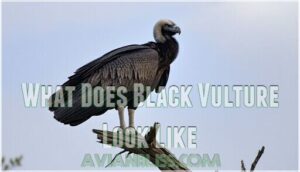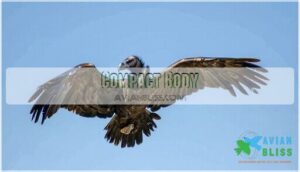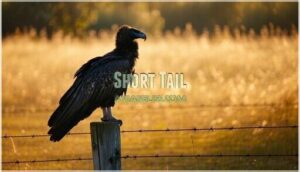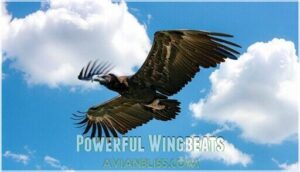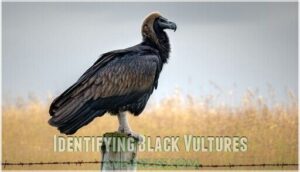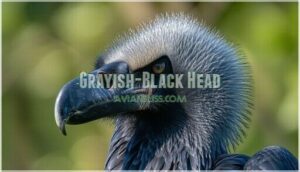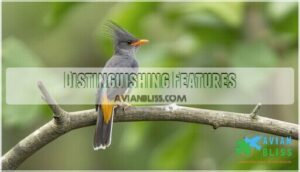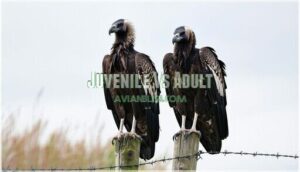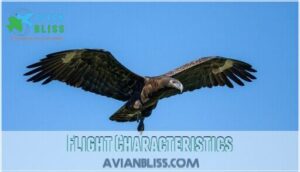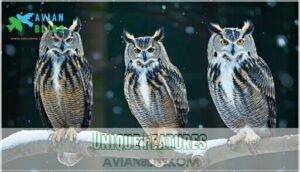This site is supported by our readers. We may earn a commission, at no cost to you, if you purchase through links.
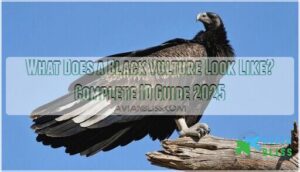
Their scavenger nature is highlighted by a distinctive bare, wrinkled black head that looks like worn leather, paired with a powerful hooked bill perfect for their carrion diet.
Their stocky build features broad wings and a short, square tail that makes them easy to identify in flight, with pale gray legs and silvery wingtip patches that flash like beacons when they soar.
Unlike other raptors, black vultures have a compact appearance with a unique silhouette, and their hunched posture while feeding gives them an unmistakable silhouette that’s hard to miss once you know their signature features.
Table Of Contents
- Key Takeaways
- Black Vulture Appearance
- What Does Black Vulture Look Like
- Physical Characteristics
- Identifying Black Vultures
- Black Vulture Size
- Plumage and Coloration
- Distinguishing Features
- Juvenile Vs Adult
- Flight Characteristics
- Unique Features
- Frequently Asked Questions (FAQs)
- Are black vultures aggressive to humans?
- What bird is mistaken for a vulture?
- Where do black vultures live in the US?
- What does it mean if I see a black vulture?
- How can you tell the difference between a black vulture and a Turkey Vulture?
- Are Black Vultures harmful?
- What does it mean when a black vulture visits you?
- How rare is a black vulture?
- What is the habitat of Black Vultures?
- Where can Black Vultures be found?
- Conclusion
Key Takeaways
- You’ll recognize black vultures by their jet-black plumage and completely bare, wrinkled black head that looks like weathered leather, creating a stark contrast with their dark feathers.
- Look for bright white patches at the wingtips during flight – these silvery "stars" flash against their dark wings and serve as the most reliable identification feature.
- Their compact, stocky build sets them apart from other raptors with broad wings, a short square tail, and pale gray legs that distinguish them from the lankier turkey vultures.
- Adults develop a distinctive bone-colored tip on their hooked black bill while juveniles display duller plumage and darker, smoother head skin that gradually develops the characteristic wrinkles with age.
Black Vulture Appearance
You’ll instantly recognize a black vulture by its distinctive sooty black plumage and completely bare, wrinkled black head that looks like it’s wearing a leather mask.
Nature’s undertaker soars overhead with a wrinkled leather mask and flashing white wingtip stars.
The most striking feature you’ll notice in flight is the bright white patches near the wingtips that flash like stars against the dark wings, which is a notable characteristic to identify the bird.
Sooty Black Plumage
You’ll immediately notice the black vulture’s distinctive sooty black plumage that sets it apart from other raptors.
This glossy, coal-dark feather condition creates a uniform appearance without the brownish tones found in turkey vultures.
The plumage glossiness becomes more pronounced as juveniles mature through the molting process, progressing from dull juvenile plumage to the characteristic lustrous black vulture identification feature that defines these remarkable scavengers, with their uniform appearance.
Bare Black Head
One of the Black Vulture’s most striking features is its completely featherless head and neck.
You’ll notice the wrinkled, leathery skin appears dark grayish-black, creating a stark contrast against the bird’s glossy black plumage.
- Head Skin Texture: Wrinkled, leathery appearance resembling old leather
- Head Color Variation: Dark grayish-black skin with minimal color changes
- Juvenile Head Color: Slightly paler than adults, gradually darkening with age
- Head Feather Absence: Completely bare from head to upper neck region
- Head Size Comparison: Noticeably small compared to the bird’s stocky body
White Wingtip Patches
Beyond that distinctive bare head, you’ll notice the Black Vulture’s most striking feature: brilliant white wingtip patches that flash like beacons during flight identification.
These silvery markings contrast sharply against their dark plumage, serving as nature’s spotlight.
Juvenile patterns show less distinct white wing tips that develop into bold patches as birds mature, making patch development a reliable aging tool.
What Does Black Vulture Look Like
When you spot a Black Vulture in the wild, you’ll notice a bird that looks like it’s dressed for a funeral. This species showcases striking vulture physical characteristics that make identification straightforward once you know what to look for.
Black vultures are nature’s undertakers – dressed head to toe in funeral attire.
The Black Vulture’s appearance centers around its jet-black plumage that covers most of its body, creating a uniform dark silhouette against the sky. The most distinctive feature you’ll observe is the bare, wrinkled head that’s completely featherless.
These head wrinkles give the bird a weathered, ancient appearance that’s both fascinating and slightly unsettling. The vulture anatomy includes a strongly hooked bill shape that’s perfectly designed for its scavenging lifestyle, with adults displaying a bone-colored tip.
Black vultures are known to exhibit adaptable feeding habits, consuming carrion, fruits, and even waste. You’ll also notice the pale gray leg color extending down to weak feet that are better suited for walking than grasping.
The feather condition appears glossy in adults, while the vulture size typically ranges from 23-27 inches in length, making them smaller than their Turkey Vulture cousins but larger than most hawks.
Physical Characteristics
Black vultures possess distinctive physical features that make them surprisingly easy to identify once you know what to look for.
Their compact build sets them apart from the lankier turkey vultures you might spot soaring overhead, while their broad wings and short tail create a unique silhouette that’s hard to mistake for any other bird, with their broad wings being a notable characteristic.
Compact Body
Discovering Black Vulture body proportions reveals nature’s engineering at its finest. These compact birds pack impressive muscle density into their stocky frames, optimizing flight efficiency while maintaining thermal regulation capabilities.
You’ll notice their powerful build supports exceptional agility maneuvering during soaring.
- Stocky, robust frame resembles a flying linebacker rather than graceful dancer
- Shorter torso compared to Turkey Vultures creates aerodynamic advantage
- Dense chest muscles power strong wingbeats for quick takeoffs
- Compact design helps with precise thermal regulation in varying climates
Broad Wings
You’ll notice the Black Vulture’s broad wings create an impressive silhouette against the sky.
These wide, rounded wings serve as natural airfoils for efficient lift generation. The broad wing function allows exceptional flight stability during soaring, helping them ride thermals with minimal energy.
Their soaring technique relies on this expansive wing shape to stay aloft for hours. Black vultures use their broad wings differently than narrow-winged raptors, prioritizing steady gliding over quick maneuvers, which is made possible by their broad wings and allows for efficient lift generation.
Short Tail
Unlike other raptors with long, elegant tails, you’ll notice the Black Vulture’s remarkably short tail creates a distinctive square-cut appearance.
This compact tail function enhances flight maneuverability during low-altitude scavenging flights.
When perched, the short tail barely extends beyond folded wingtips, helping with perch balance on narrow branches.
This tail length distinguishes Black Vultures from Turkey Vultures, whose longer tails create different flight silhouettes for vulture identification purposes.
Powerful Wingbeats
You’ll recognize Black Vultures by their distinctive power-stroke flight pattern that sets them apart from their soaring cousins.
Their powerful wings help with predator evasion and maintain their stocky vulture appearance despite their shorter vulture wingspan compared to other species.
These birds rely on rapid, deep wingbeats for flight efficiency rather than effortless gliding, creating higher energy expenditure during migration patterns.
Identifying Black Vultures
You’ll recognize black vultures by their distinctive featherless black head that looks like wrinkled leather and their strong, hooked bill with a bone-colored tip.
These compact scavengers also sport pale gray legs that extend past their short tails, creating a unique silhouette that’s hard to miss once you know what to look for.
Featherless Head
You’ll spot the black vulture’s most distinctive feature right away — its completely bare, featherless head.
This adaptation serves three essential purposes:
- Head Thermoregulation keeps the bird cool during hot weather
- Hygiene Adaptation prevents bacteria buildup when feeding on carrion
- Bill Attachment provides a clean connection point for the hooked beak
The grayish-black skin appears wrinkled and leathery, especially noticeable in adults.
Unlike the black vulture, the king vulture sports vibrant colors on its featherless head.
Juvenile head coloration starts paler but darkens with maturity, developing the characteristic skin wrinkles that aid in black vulture identification.
Hooked Bill
Beyond the featherless head, you’ll notice the Black Vulture’s bill is a formidable tool shaped like a meat hook.
This dark, strongly hooked bill shows remarkable Bill Strength for tearing through tough hide and muscle.
The bill’s sharp curve and pointed tip demonstrate perfect Feeding Adaptations for their scavenging lifestyle.
Bill Development creates this specialized bird anatomy feature that’s darker than other vultures, with adults showing a distinctive bone-colored tip that contrasts against their sooty black plumage.
Pale Gray Legs
You’ll notice the pale gray leg coloration extends from the bird’s unfeathered ankles down to its feet.
These pale gray legs provide excellent walking adaptation, as Black Vulture foot structure evolved for ground movement rather than grasping prey.
Unlike darker plumage covering the body, juvenile legs maintain the same gray tone as adults, making leg coloration a reliable identification feature across all ages, which is a key aspect of their ground movement.
Black Vulture Size
Understanding black vulture size helps you distinguish them from other large raptors in the field.
These impressive scavengers measure 24-27 inches long with wingspans reaching 4.5-5 feet, making them slightly smaller than turkey vultures but considerably larger than most hawks.
Wingspan
Black Vulture wingspan measures 53.9-59.1 inches, making these birds impressive aerial scavengers.
Their compact wings deliver surprising Flight Efficiency despite being shorter than turkey vultures.
Black vultures often follow turkey vultures to find food, showcasing their reliance on scavenging.
Key wingspan features include:
- Wingspan Variation ranges from 4.5-5.6 feet across populations
- Broad, rounded wings provide excellent Soaring Ability
- Northern populations show larger measurements than tropical forms
- Habitat Influence shapes wing proportions for maneuverability
- Evolutionary Advantage balances soaring with powerful flapping flight
Body Length
Measuring a black vulture reveals consistency that’d make a scientist smile.
Average length spans 23-27 inches, with minimal sexual dimorphism between males and females.
Regional variation exists but stays within this range.
Juvenile length matches adult measurements, making age determination tricky through size alone.
Accurate body measurements require proper positioning from bill tip to tail.
They also have a distinctive bald, gray-black head which aids in hygiene and is a key characteristic.
Weight
Adult Black Vultures typically weigh between 3.5 to 6.6 pounds, with Average Weight varying by location.
Regional Variation shows temperate birds reaching heavier measurements while tropical populations stay lighter.
Juvenile Weight starts at the lower range after fledging.
Unlike some birds, Black Vultures don’t show significant Weight Fluctuation seasonally.
This substantial bird weight supports their powerful soaring flight and Weight Impact on their scavenging efficiency.
Plumage and Coloration
You’ll quickly notice a black vulture’s striking glossy black plumage that covers its entire body and wings, creating an unmistakable silhouette against the sky.
The most distinctive feature is the bright white patches on the undersides of their wingtips, which flash like stars when they spread their wings in flight.
Glossy Black Plumage
Looking at this magnificent scavenger, you’ll spot plumage that’s truly eye-catching.
The Black Vulture’s feathers create a stunning glossy black appearance that seems almost metallic in bright sunlight.
This plumage iridescence helps with thermal regulation while giving these birds their signature look.
Unlike juvenile plumage, which appears duller, adult feathers maintain excellent feather condition through their natural molting process, keeping wings aerodynamic for effortless soaring, which is crucial for their effortless flight.
White Underwing Patches
Throughout the sky, you’ll notice distinct white underwing patches that make Black Vulture identification straightforward.
These white stars under wingtips create striking sunlight reflection patterns during flight.
Patch size remains consistent between juvenile patches and adult plumage, though juvenile patches appear slightly duller.
The patch variation helps distinguish Black Vultures from other species when identifying vultures overhead, using the white underwing patches.
Grayish-Black Head
You’ll notice the Black Vulture’s most distinctive feature: its completely featherless, grayish-black head covered in wrinkled skin.
This black scavenger bird’s head appears disproportionately small compared to its stocky body, creating a unique silhouette when identifying vultures.
The juvenile head starts paler but darkens with age.
Look for the dark bill color with a bone-colored tip and unique nostril structure – the nostrils actually connect through the beak without a septum.
These head wrinkles help distinguish this allblack plumage species from other raptors, and are a key feature to note when trying to identify the Black Vulture based on its completely featherless head and unique silhouette.
Distinguishing Features
You’ll spot black vultures by their distinctive black wings marked with bright white "stars" at the tips, visible during flight.
These compact raptors differ from turkey vultures with their shorter, broader wings and more powerful wingbeats that create a steady soaring pattern.
Black Wings
You’ll notice Black Vulture wings display uniform black coloration that serves multiple purposes in their survival strategy.
Wing molting occurs gradually, maintaining feather health throughout the year.
Their flight aerodynamics rely on these broad, dark wings for efficient soaring and thermal regulation in various climates.
Here are five key wing characteristics:
- Solid black feathers create effective camouflage purpose against dark backgrounds
- Broad wing span enables powerful flight patterns during soaring
- Dense feather coverage provides insulation and weather protection
- Rounded wing tips optimize lift generation for heavy body weight
- Consistent coloration distinguishes them from other raptors year-round
White Stars
You’ll notice these distinctive white stars right at the Black Vulture’s wingtips during flight.
These bright white patches create a stunning contrast against their dark feathers, making Flight Identification much easier.
Adult Black Vultures show prominent white stars, while juvenile birds display smaller, less defined patches.
This Wingtip Variation helps distinguish them from Turkey Vultures, and the Star Function serves an important purpose in flight dynamics, depending on lighting and angle.
Juvenile Vs Adult
You’ll notice that juvenile black vultures look distinctly different from adults, with duller plumage that lacks the glossy sheen of mature birds.
The young birds also sport paler, grayish heads instead of the jet-black wrinkled skin you’ll see on adults, and their white wing patches may be less pronounced until they reach maturity.
Dull Black Plumage
While distinguishing between adult and juvenile Black Vultures, you’ll notice juvenile plumage appears noticeably duller than their glossy adult counterparts.
This large black bird’s feathers lack the iridescent sheen that develops through the molting process.
Young vultures display muted black coloration with softer feather condition before achieving the sleek appearance and vibrant color pattern of mature birds.
| Age Group | Feather Quality |
|---|---|
| Juvenile | Dull, matte finish |
| Adult | Glossy, iridescent |
| Fledgling | Soft texture |
| Mature | Sleek, refined |
| Yearling | Developing sheen |
Pale Head
You’ll notice the head coloration changes dramatically between juvenile and adult Black Vultures.
Juvenile head skin appears darker and smoother, while adults develop wrinkled skin that’s pale grayish-black.
Bill color shifts from solid black in juveniles to bone-colored tips in adults.
Notably, some birds such as the White-headed Vulture share similar characteristics.
| Feature | Juvenile | Adult |
|---|---|---|
| Head Coloration | Darker black skin | Pale grayish-black |
| Skin Texture | Smooth surface | Deep wrinkles |
| Bill Color | Solid black | Black with bone tip |
| Head Size | Proportionally smaller | Fuller appearance |
| Neck Feathering | More extensive | Less feathered |
The key differences between juvenile and adult Black Vultures can be summarized as dramatic changes in their physical characteristics, including head coloration, skin texture, and bill color.
White Wing Patches
Both juvenile and adult Black Vultures sport distinctive white wing patches that shine like beacons during flight identification.
You’ll spot these silvery wingtip patches on the undersides of their outer primaries, creating stunning underwing contrast against black feathers.
While juveniles show slightly less defined markings due to fresher feather development, the patch size remains consistent across ages.
| Feature | Juvenile | Adult |
|---|---|---|
| Wing Patch Clarity | Somewhat muted | Sharply defined |
| Contrast Level | Moderate | High |
| Feather Condition | Fresh, soft | Worn, sleek |
| Visibility | Good | Excellent |
These white wing tips serve as your most reliable field mark for bird identification, distinguishing Black Vultures from other species regardless of age.
Flight Characteristics
When you spot a black vulture soaring overhead, you’ll notice its broad, rounded wings held flat in a distinctive flight pattern.
The bird’s short, square tail creates a compact silhouette that sets it apart from other large raptors in the sky, with its broad, rounded wings being a notable feature.
Broad Rounded Wings
When you spot Black Vultures soaring overhead, their wing shape tells the whole story.
These birds sport distinctly broad, rounded wings that stay flat during flight, creating remarkable flight stability.
Here’s what makes their wing shape special:
- Wing shape: Perfectly rounded tips maximize thermal usage efficiency
- Flight stability: Broad wings provide steady, controlled soaring technique
- Wing loading: Lower ratio allows effortless gliding on thermals
- Flight characteristics: Flat wing position differs from Turkey Vultures’ V-shape
- Flight behavior: Powerful wingbeats alternate with graceful soaring
This wing design makes Black Vultures masters of energy conservation during flight.
Other birds, like the broad winged hawk, also use broad wings, but for different hunting and migration strategies.
Short Square Tail
Black Vulture’s tail function becomes clear when you watch them soar overhead.
Their short square tail shape creates a distinctive flight silhouette that’s easy to spot.
Unlike turkey vultures with longer tails, Black Vultures sport compact tail feather arrangements.
Both juvenile and adult birds share this square tail design, though juvenile tail feathers may appear slightly duller.
This tail aerodynamics setup helps these powerful birds maintain stability during their characteristic steady soaring patterns.
Unique Features
When you spot a Black Vulture, you’ll notice three standout features that set it apart from other large birds.
The unfeathered black head looks like wrinkled leather, while silvery-white patches flash under the wingtips during flight.
Adults show a distinctive pale tip on their otherwise dark hooked bill.
Unfeathered Black Head
You’ll notice the most striking feature when you look at a Black Vulture’s head.
This bare, unfeathered area sets them apart from other birds you might encounter.
- Head Skin Texture: Wrinkled, leathery skin covers the entire head and neck
- Head Color Variation: Dark grayish-black coloration that’s consistent year-round
- Juvenile Head: Young birds show paler heads that darken with maturity
- Bill Attachment: The hooked bill connects seamlessly to the bare head skin
- Head Size: Proportionally small compared to their stocky body frame
Silvery Wingtip Patches
You’ll recognize the Black Vulture’s most striking feature when it soars overhead.
Those brilliant white patches flash like beacons against jet-black wings, creating unmistakable "stars" at the wingtips.
Sunlight Reflection turns these Feather Composition details into silvery signals visible from great distances.
| Feature | Adult | Juvenile |
|---|---|---|
| Patch Iridescence | Bright white | Duller white-gray |
| Regional Variation | Consistent | Variable intensity |
| Wingspan display | Sharp contrast | Muted contrast |
These Juvenile Markings develop gradually, with young birds showing less dramatic bird anatomy details until maturity.
Pale Bill Tip
Adult Black Vultures sport distinctive bone-colored or pale bill tips that contrast sharply with their otherwise dark beaks.
This Bill Tip Color serves as a reliable identification marker, especially when distinguishing adults from juveniles.
Young birds lack this pale coloration, displaying uniformly dark bills throughout.
The Adult Bill’s pale tip develops gradually as birds mature, making it a useful physical feature for aging these impressive scavengers in the field.
Frequently Asked Questions (FAQs)
Are black vultures aggressive to humans?
Generally, you don’t need to worry about black vultures being aggressive toward humans. They’re scavengers that prefer to avoid confrontation and will typically fly away when you approach them.
What bird is mistaken for a vulture?
Imagine this scenario: you’re scanning the sky when a large, dark bird circles overhead.
Zone-tailed Hawks often fool birdwatchers because they cleverly mimic Turkey Vultures, soaring alongside them with similar flight patterns and dark plumage.
Where do black vultures live in the US?
You’ll find black vultures throughout the southeastern United States, from Texas to Florida and up the Atlantic coast to southern New Jersey. They’re expanding their range northward as temperatures warm.
What does it mean if I see a black vulture?
Unlike their fearsome appearance, black vultures signal nature’s cleanup crew at work. You’re witnessing efficient scavengers that help maintain ecological balance by removing carrion, keeping environments healthy and disease-free.
How can you tell the difference between a black vulture and a Turkey Vulture?
You can distinguish Black Vultures from Turkey Vultures by their shorter, broader wings with white "star" patches underneath, compact bodies, and bare black heads.
Versus Turkey Vultures’ longer wings and red heads.
Are Black Vultures harmful?
Black vultures aren’t typically harmful to humans, but they can kill small livestock like lambs and calves. They’re attracted to garbage and sometimes damage property when roosting in large flocks.
What does it mean when a black vulture visits you?
Though many see vultures as bad omens, a black vulture visit typically means nothing supernatural—you’re simply near their habitat or a food source.
They’re drawn to carrion, garbage, or open areas for roosting, not mystical reasons, which explains why they might be seen in certain areas without any supernatural connotations.
How rare is a black vulture?
You won’t find black vultures rare at all.
They’re abundant in the southeastern U.S., with a global population around 190 million birds.
They’re actually expanding their range northward, so you’ll spot them more often these days.
What is the habitat of Black Vultures?
Like feathered landlords claiming prime real estate, you’ll find Black Vultures thriving in open areas.
They roost in large colonies on dead trees, cell towers, and rooftops.
While nesting in dark rocky crevices and caves.
Where can Black Vultures be found?
You’ll spot these birds across the southeastern United States, through Central and South America, hanging out in open fields, forests, and even city rooftops.
If you see a big, dark bird circling, it’s probably them.
Conclusion
Did you know black vultures can soar for hours without flapping their wings?
Now that you know what does a black vulture look like, spotting one becomes much easier.
Remember their jet-black feathers, white wingtip patches, and bare, wrinkled heads.
Their compact bodies and short tails set them apart from other raptors.
Next time you see a bird circling overhead, look for these features, and you’ll impress your friends and maybe even outsmart a curious vulture!
- https://seaworld.org/animals/facts/birds/black-vulture/
- https://www.chattnaturecenter.org/visit/experience/wildlife/animal-facts/black-vulture/
- https://www.tn.gov/twra/wildlife/birds/grassland-and-shrub-birds/black-vulture.html
- https://abcbirds.org/bird/black-vulture/
- https://stateofthebirds.nhaudubon.org/bird_database/black-vulture/


